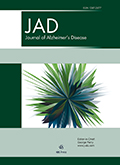Authors: Chum, Phoebe P. | Bishara, Mary A. | Solis, Summer R. | Behringer, Erik J.
Article Type:
Research Article
Abstract:
Background: Alzheimer’s disease (AD) is associated with impaired cerebral circulation which underscores diminished delivery of blood oxygen and nutrients to and throughout the brain. In the 3xTg-AD mouse model, we have recently found that > 10 cerebrovascular miRNAs pertaining to vascular permeability, angiogenesis, and inflammation (e.g., let-7d, miR-99a, miR-132, miR-133a, miR-151-5p, and miR-181a) track early development of AD. Further, endothelial-specific miRNAs (miR-126-3p, miR-23a/b, miR-27a) alter with onset of overall AD pathology relative to stability of smooth muscle/pericyte-specific miRNAs (miR-143, miR-145). Objective: We tested the hypothesis that cerebrovascular miRNAs indicating AD pathology share mRNA targets that regulate key endothelial cell functions
…such as angiogenesis, vascular permeability, and blood flow regulation. Methods: As detected by NanoString nCounter miRNA Expression panel for 3xTg-AD mice, 61 cerebrovascular miRNAs and respective mRNA targets were examined using Ingenuity Pathway Analysis for canonical Cardiovascular (Cardio) and Nervous System (Neuro) Signaling. Results: The number of targets regulated per miRNA were 21±2 and 33±3 for the Cardio and Neuro pathways respectively, whereby 14±2 targets overlap among pathways. Endothelial miRNAs primarily target members of the PDE, PDGF, SMAD, and VEGF families. Individual candidates regulated by≥4 miRNAs that best mark AD pathology presence in 3xTg-AD mice include CFL2, GRIN2B, PDGFB, SLC6A1, SMAD3, SYT3, and TNFRSF11B. Conclusion: miRNAs selective for regulation of endothelial function and respective downstream mRNA targets support a molecular basis for dysregulated cerebral blood flow regulation coupled with enhanced cell growth, proliferation, and inflammation.
Show more
Keywords: Alzheimer’s disease, brain endothelium, mRNA targets, vascular dysfunction
DOI: 10.3233/JAD-230300
Citation: Journal of Alzheimer's Disease,
vol. Pre-press, no. Pre-press, pp. 1-48, 2023
Price: EUR 27.50





